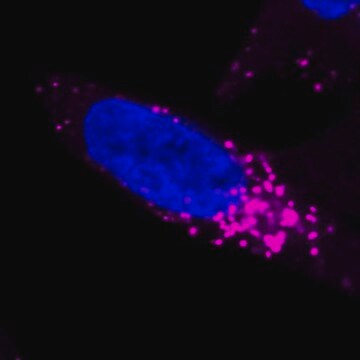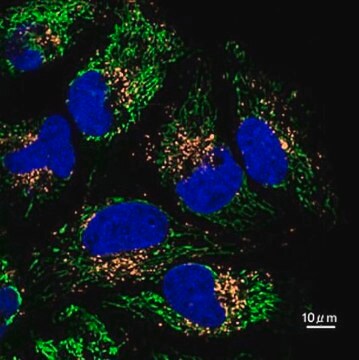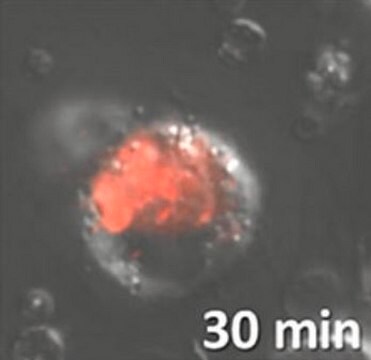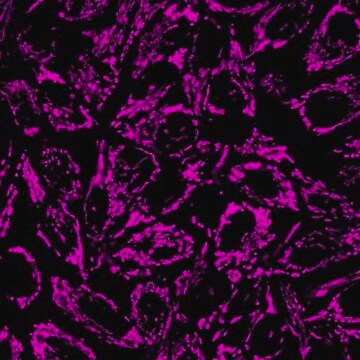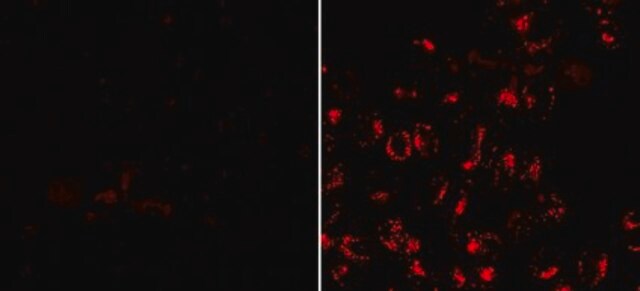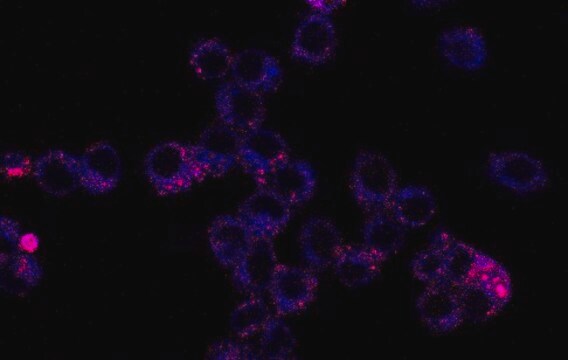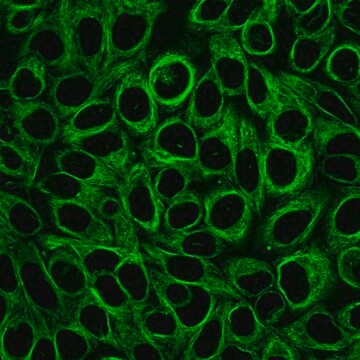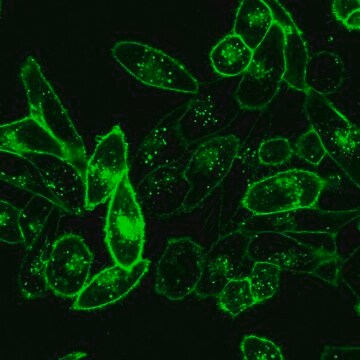SCT044
BioTracker LYSO-TP Live Cell Dye
Live cell imaging dye for hypochlorous acid (HOCl) targeted to cellular lysosomes used to detect phagocytosis, inflammation and cellular apoptosis.
Sinonimo/i:
Live cell imaging probe
Autenticatiper visualizzare i prezzi riservati alla tua organizzazione & contrattuali
About This Item
Codice UNSPSC:
12352207
NACRES:
NA.47
Prodotti consigliati
Saggio
≥98% (H-NMR)
≥98% (HPLC)
≥98% (LC/MS)
≥98% (elemental analysis)
tecniche
cell based assay: suitable
Metodo di rivelazione
fluorometric
Condizioni di spedizione
ambient
Descrizione generale
Hypochlorous acid (HOCl) is a highly potent reactive oxygen species (ROS) and helps eliminate pathogens in the innate immune system. Mounting evidence indicates that intracellular HOCl plays additional important roles in regulating inflammation and cellular apoptosis. Subcellular detection of HOCL is currently limited due to low concentration, strong oxidization, and short lifespan of the analyte.
The BioTracker LYSO-TP dye is a live cell two-photon green fluorescent turn-on imaging probe for HOCL. The probe targets HOCL specifically in the lysosomes of cells. The probe exhibit fast response times, good selectivity, and high sensitivity towards hypochlorous acid in living cells. Acedan was chosen as the fluorescence reporting group due to its excellent photophysical properties resulting from the typical push−pull (amineketone) structure. Reaction of the probe with HOCl, which deprotects the oxathiolane/mercaptal group to reveal the ketone, would lead to fluorescence enhancement. To monitor subcellular HOCL levels, morpholine was introduced at a long distance from the reaction site to ensure the probes intracellular localization.
Spectral Properties
Absorbance: 375nm
Emission: 500nm
The BioTracker LYSO-TP dye is a live cell two-photon green fluorescent turn-on imaging probe for HOCL. The probe targets HOCL specifically in the lysosomes of cells. The probe exhibit fast response times, good selectivity, and high sensitivity towards hypochlorous acid in living cells. Acedan was chosen as the fluorescence reporting group due to its excellent photophysical properties resulting from the typical push−pull (amineketone) structure. Reaction of the probe with HOCl, which deprotects the oxathiolane/mercaptal group to reveal the ketone, would lead to fluorescence enhancement. To monitor subcellular HOCL levels, morpholine was introduced at a long distance from the reaction site to ensure the probes intracellular localization.
Spectral Properties
Absorbance: 375nm
Emission: 500nm
Applicazioni
Live cell fluorescent imaging
Research Category
Cell Imaging
Cell Imaging
Research Sub Category
Live Cell Dye
Live Cell Dye
Qualità
Purity: ≥ 98% confirmed by HNMR, LC-MS and HPLC and elemental analysis
Molar Mass: 357.49 g/mol
Molar Mass: 357.49 g/mol
Stato fisico
Lyophilized
Stoccaggio e stabilità
Store BioTracker LYSO-TP Live Cell Dye at -20°C, desiccate and protect from light
Note: Centrifuge vial briefly to collect contents at bottom of vial before opening.
Note: Centrifuge vial briefly to collect contents at bottom of vial before opening.
Esclusione di responsabilità
Unless otherwise stated in our catalog or other company documentation accompanying the product(s), our products are intended for research use only and are not to be used for any other purpose, which includes but is not limited to, unauthorized commercial uses, in vitro diagnostic uses, ex vivo or in vivo therapeutic uses or any type of consumption or application to humans or animals.
Codice della classe di stoccaggio
11 - Combustible Solids
Classe di pericolosità dell'acqua (WGK)
WGK 3
Punto d’infiammabilità (°F)
Not applicable
Punto d’infiammabilità (°C)
Not applicable
Certificati d'analisi (COA)
Cerca il Certificati d'analisi (COA) digitando il numero di lotto/batch corrispondente. I numeri di lotto o di batch sono stampati sull'etichetta dei prodotti dopo la parola ‘Lotto’ o ‘Batch’.
Possiedi già questo prodotto?
I documenti relativi ai prodotti acquistati recentemente sono disponibili nell’Archivio dei documenti.
I clienti hanno visto anche
Lin Yuan et al.
Journal of the American Chemical Society, 137(18), 5930-5938 (2015-04-24)
Hypochlorous acid (HOCl), as a highly potent oxidant, is well-known as a key "killer" for pathogens in the innate immune system. Recently, mounting evidence indicates that intracellular HOCl plays additional important roles in regulating inflammation and cellular apoptosis. However, the
Il team dei nostri ricercatori vanta grande esperienza in tutte le aree della ricerca quali Life Science, scienza dei materiali, sintesi chimica, cromatografia, discipline analitiche, ecc..
Contatta l'Assistenza Tecnica.